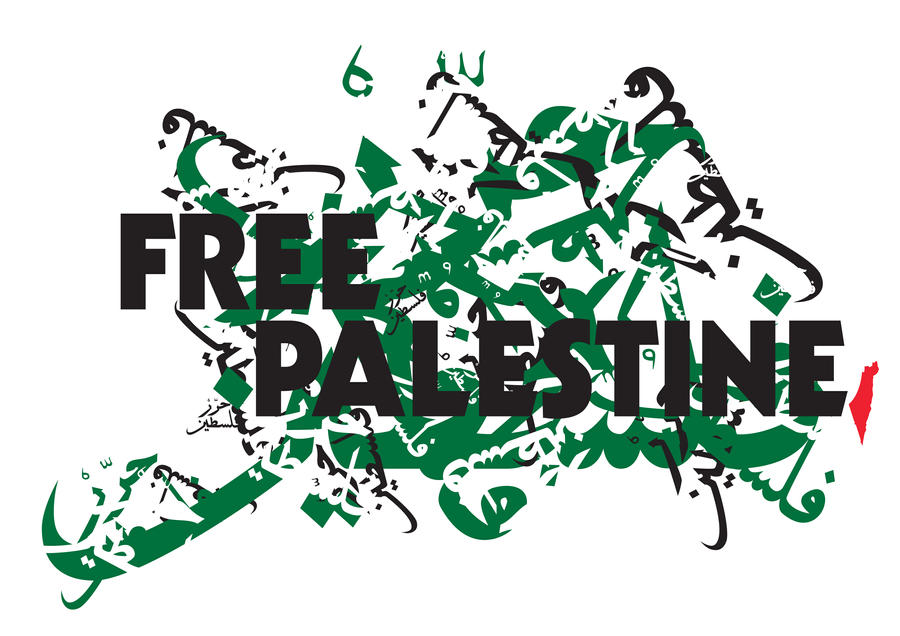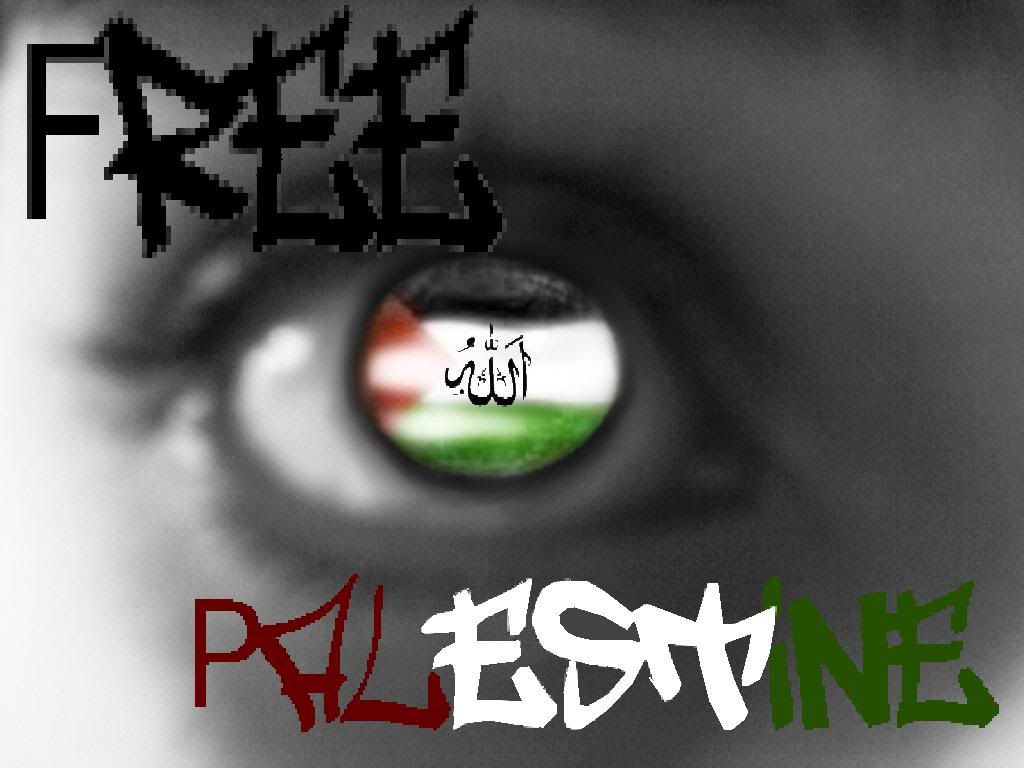Source(google.com.pk)
Free Palestine Wallpaper Biography
Palestine lies to the west of the Asian continent between longitudes 15-34 and 40-35 to the east, and between latitudes 30-29 and 15-33 to the north.
Palestine constitutes the southwestern part of a huge geographical unity in the eastern part of the Arab world, which is Belad El-Sham. In addition to Palestine, Sham contains Lebanon, Syria and Jordan. It used to have common borders with these countries, in addition to Egypt.
The borders of Palestine start with Lebanon at Ras El-Nakoura at the Mediterranean sea and head in a straight line to the east till it reaches the area beyond the small Lebanese city of Bent Jubayel, where the separating line between the two countries curves to the north at a straight angle. At that point, the border comes around the fountain of the River Jordan, and a narrow passage adjacent to it from the east connects it with the land of Syria and the lakes Al-Hola, Lout and Tabarriyya.
The border with Jordan begins to the south of Tabarriyya Lake at the drainage of Al-Yarmouk River. It continues along the River Jordan. From the fountain of the River Jordan, the border heads south across the geometrical middle of the Dead Sea and the Araba Valley till it reaches the gulf of Aqaba.
The borders with Egypt could be compared to a straight line that separates the semi-island of Seena and Al-Naqab desert. The border begins at Rafah at the Mediterranean Sea till it reaches Taba at the Gulf of Aqaba.
On the west side, Palestine lies next to the international open waters of the Mediterranean Sea at a distance of about 250 km from Ras El-Nakoura in the north to Rafah in the south.
Because of its location in the middle of several Arab countries, Palestine constitutes a combination of natural and humanistic geography for a wide terrestrial field that comprises the originality of Bedouin life in the south and the style of long settlement in the north. The Palestinian land is featured with being part of the first man's home, the place for all the celestial religions, the place were ancient civilizations rose and a bridge for commercial activities and the military incursions across so many different historical eras. The strategic location Palestine enjoys allowed it to be a connecting factor between the continents of the ancient worlds of Asia, Africa and Europe. It is a place that allows for easy travel to other adjacent places. It was a crossing bridge for people from a long time, and it enjoys a focal location that attracts all those who want to settle down and live in prosperity. Therefore, it is quite natural that Palestine was the centre for the greed of many to have it under control and to exploit its merits.
For both peace and war, the location of Palestine is of great significance. In the ancient times, Palestine represented one of the most important trade routes. It connected the homes of civilizations of the Nile Valley and the southern areas of the Arab peninsula on one hand and the homes of civilizations in the northern areas in Belad El-Sham and Iraq on the other. Palestine has always been a passage for trade caravans before and after the coming of Islam. The Arab caravans used to head to Palestine from the Arab peninsula in the summer as part of the summer and winter journeys mentioned in the Holy Qur'an.
It was also a passage for the Arabian tribes that came from the Arab peninsula on their way to Belad El-Sham or northern Africa. Some of these tribes settled in Palestine, while others settled in the neighbouring regions.
The importance of the commercial location of Palestine increased during the Mamaleek era when it used to be a passage for the commercial caravans that carried goods from the Far East to Europe and vice versa. The trade ships used to stop at Aden and unload their cargo so that it would be transported by caravans across Yemen and Hejaz and then to the Palestinian ports on the Mediterranean Sea. The ships in the ports waited to be loaded with different kinds of goods such as silk, perfumes, jewelry, and the like, to be transferred to European ports.
Palestine still enjoys the importance of its commercial location because it represents a connection between the seasonal and circular environments in southern Asia and the Near East on the one hand and the environments of the Mediterranean Sea and middle and western Europe on the other. There is no doubt, however, that the different environments with their varied products share a great deal of commercial transactions. Thus the location of Palestine connects the agricultural civilization of the East with the industrial civilization of the West. Therefore Palestine became an important passage for the international trade and travelers alike on land, sea and air.
On the other hand, the Palestinian ports provided its neighbours to the east in Syria and Jordan with its services till the year 1948. The Jordanian international trade depended highly upon these ports, but it changed its geographical direction after the Zionist occupation of Palestine took place. Thereafter, the Jordanian traders headed to the Lebanese and the Syrian ports, in addition to the Gulf of Aqaba. The Iraqi oil that was flowing from the field of Karkouk to the north of Iraq to Haifa's refinery also stopped in 1948.
If we exclude the Gaza port, whose services were limited to the Gaza district, the rest of the Palestinian ports, whether on the Mediterranean such as Haifa, Jaffa, Asdoud, Akka, Ashkelon or on the Gulf of Aqaba such as Elat, still provide the Zionist entity with a great service. This is because the direction of the Palestinian trade stretches across the ports of the Mediterranean Sea to Europe and North America and Latin America and across the Elat port to southern Asia and the Far East and to the eastern side of Africa.
As to the military significance of the Palestinian location, it issues in the fact that Palestine was the centre of so many military campaigns because it was a passage to other countries in for the military incursions that took place. So many nations and forces occupied Palestine such as the Babylonians, the Ashourians, Al-Hethyeen, the Persians, the Greeks and the Romans, till it was finally joined with the great Islamic State and became a very important part of it.
In the late eighteenth century, Palestine was attacked by the campaign led by Napoleon Bonaparte, whose aim was to occupy Belad El-Sham. He failed at occupying Akka because of the great bravery shown by the people of Palestine and the leader of Akka, Ahmed El-Azaz.
In the present century, Palestine was subject to a British invasion during the First World War, which led to the ousting of the Ottomans and the occupation of Palestine under the pretext of a British mandate. Britain and the allied forces took great advantage of Palestine's location in the Second World War. Before leaving Palestine on 25 May 1948, the British paved the way for the erection of a Zionist entity in Palestine to serve as a base for Western countries and as a separation point that divides the body of the Muslim Arab nation. Since 1948 up to the present, the Zionist entity still holds Palestine captive and exploits its merits and makes use of its strategic geographical location for its hostile and malicious anti-Arab plans.
Top










Free Palestine Wallpaper Biography
Palestine lies to the west of the Asian continent between longitudes 15-34 and 40-35 to the east, and between latitudes 30-29 and 15-33 to the north.
Palestine constitutes the southwestern part of a huge geographical unity in the eastern part of the Arab world, which is Belad El-Sham. In addition to Palestine, Sham contains Lebanon, Syria and Jordan. It used to have common borders with these countries, in addition to Egypt.
The borders of Palestine start with Lebanon at Ras El-Nakoura at the Mediterranean sea and head in a straight line to the east till it reaches the area beyond the small Lebanese city of Bent Jubayel, where the separating line between the two countries curves to the north at a straight angle. At that point, the border comes around the fountain of the River Jordan, and a narrow passage adjacent to it from the east connects it with the land of Syria and the lakes Al-Hola, Lout and Tabarriyya.
The border with Jordan begins to the south of Tabarriyya Lake at the drainage of Al-Yarmouk River. It continues along the River Jordan. From the fountain of the River Jordan, the border heads south across the geometrical middle of the Dead Sea and the Araba Valley till it reaches the gulf of Aqaba.
The borders with Egypt could be compared to a straight line that separates the semi-island of Seena and Al-Naqab desert. The border begins at Rafah at the Mediterranean Sea till it reaches Taba at the Gulf of Aqaba.
On the west side, Palestine lies next to the international open waters of the Mediterranean Sea at a distance of about 250 km from Ras El-Nakoura in the north to Rafah in the south.
Because of its location in the middle of several Arab countries, Palestine constitutes a combination of natural and humanistic geography for a wide terrestrial field that comprises the originality of Bedouin life in the south and the style of long settlement in the north. The Palestinian land is featured with being part of the first man's home, the place for all the celestial religions, the place were ancient civilizations rose and a bridge for commercial activities and the military incursions across so many different historical eras. The strategic location Palestine enjoys allowed it to be a connecting factor between the continents of the ancient worlds of Asia, Africa and Europe. It is a place that allows for easy travel to other adjacent places. It was a crossing bridge for people from a long time, and it enjoys a focal location that attracts all those who want to settle down and live in prosperity. Therefore, it is quite natural that Palestine was the centre for the greed of many to have it under control and to exploit its merits.
For both peace and war, the location of Palestine is of great significance. In the ancient times, Palestine represented one of the most important trade routes. It connected the homes of civilizations of the Nile Valley and the southern areas of the Arab peninsula on one hand and the homes of civilizations in the northern areas in Belad El-Sham and Iraq on the other. Palestine has always been a passage for trade caravans before and after the coming of Islam. The Arab caravans used to head to Palestine from the Arab peninsula in the summer as part of the summer and winter journeys mentioned in the Holy Qur'an.
It was also a passage for the Arabian tribes that came from the Arab peninsula on their way to Belad El-Sham or northern Africa. Some of these tribes settled in Palestine, while others settled in the neighbouring regions.
The importance of the commercial location of Palestine increased during the Mamaleek era when it used to be a passage for the commercial caravans that carried goods from the Far East to Europe and vice versa. The trade ships used to stop at Aden and unload their cargo so that it would be transported by caravans across Yemen and Hejaz and then to the Palestinian ports on the Mediterranean Sea. The ships in the ports waited to be loaded with different kinds of goods such as silk, perfumes, jewelry, and the like, to be transferred to European ports.
Palestine still enjoys the importance of its commercial location because it represents a connection between the seasonal and circular environments in southern Asia and the Near East on the one hand and the environments of the Mediterranean Sea and middle and western Europe on the other. There is no doubt, however, that the different environments with their varied products share a great deal of commercial transactions. Thus the location of Palestine connects the agricultural civilization of the East with the industrial civilization of the West. Therefore Palestine became an important passage for the international trade and travelers alike on land, sea and air.
On the other hand, the Palestinian ports provided its neighbours to the east in Syria and Jordan with its services till the year 1948. The Jordanian international trade depended highly upon these ports, but it changed its geographical direction after the Zionist occupation of Palestine took place. Thereafter, the Jordanian traders headed to the Lebanese and the Syrian ports, in addition to the Gulf of Aqaba. The Iraqi oil that was flowing from the field of Karkouk to the north of Iraq to Haifa's refinery also stopped in 1948.
If we exclude the Gaza port, whose services were limited to the Gaza district, the rest of the Palestinian ports, whether on the Mediterranean such as Haifa, Jaffa, Asdoud, Akka, Ashkelon or on the Gulf of Aqaba such as Elat, still provide the Zionist entity with a great service. This is because the direction of the Palestinian trade stretches across the ports of the Mediterranean Sea to Europe and North America and Latin America and across the Elat port to southern Asia and the Far East and to the eastern side of Africa.
As to the military significance of the Palestinian location, it issues in the fact that Palestine was the centre of so many military campaigns because it was a passage to other countries in for the military incursions that took place. So many nations and forces occupied Palestine such as the Babylonians, the Ashourians, Al-Hethyeen, the Persians, the Greeks and the Romans, till it was finally joined with the great Islamic State and became a very important part of it.
In the late eighteenth century, Palestine was attacked by the campaign led by Napoleon Bonaparte, whose aim was to occupy Belad El-Sham. He failed at occupying Akka because of the great bravery shown by the people of Palestine and the leader of Akka, Ahmed El-Azaz.
In the present century, Palestine was subject to a British invasion during the First World War, which led to the ousting of the Ottomans and the occupation of Palestine under the pretext of a British mandate. Britain and the allied forces took great advantage of Palestine's location in the Second World War. Before leaving Palestine on 25 May 1948, the British paved the way for the erection of a Zionist entity in Palestine to serve as a base for Western countries and as a separation point that divides the body of the Muslim Arab nation. Since 1948 up to the present, the Zionist entity still holds Palestine captive and exploits its merits and makes use of its strategic geographical location for its hostile and malicious anti-Arab plans.
Top
Free Palestine Wallpaper

Free Palestine Wallpaper

Free Palestine Wallpaper

Free Palestine Wallpaper

Free Palestine Wallpaper
Free Palestine Wallpaper
Free Palestine Wallpaper

Free Palestine Wallpaper

Free Palestine Wallpaper

Free Palestine Wallpaper

Free Palestine Wallpaper
No comments:
Post a Comment